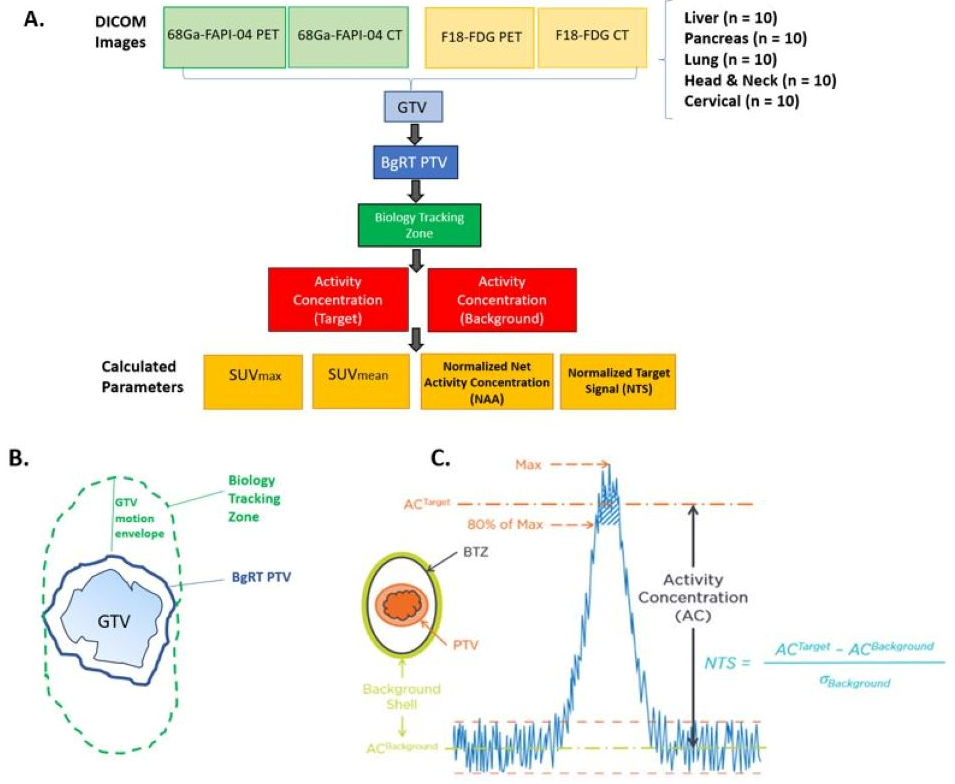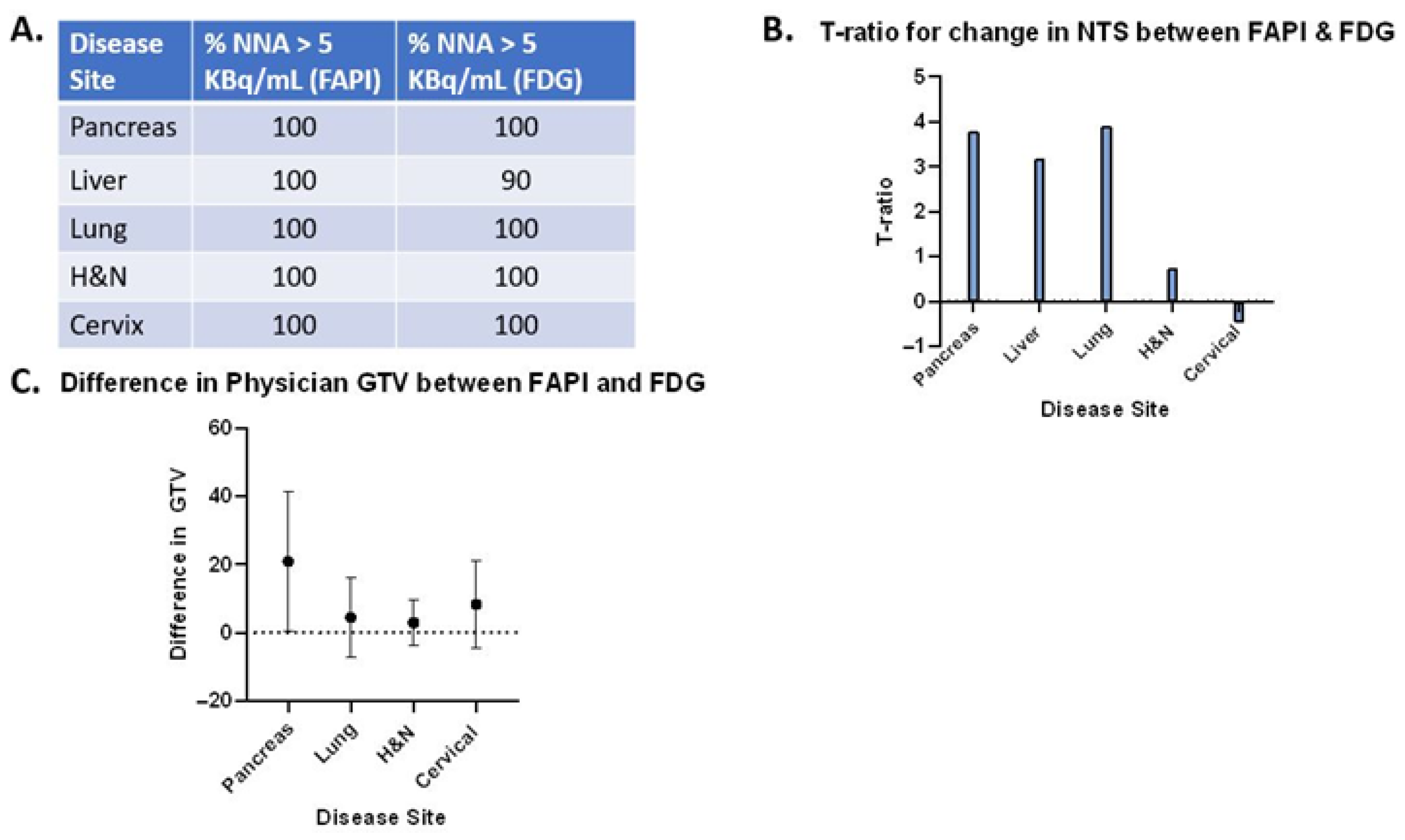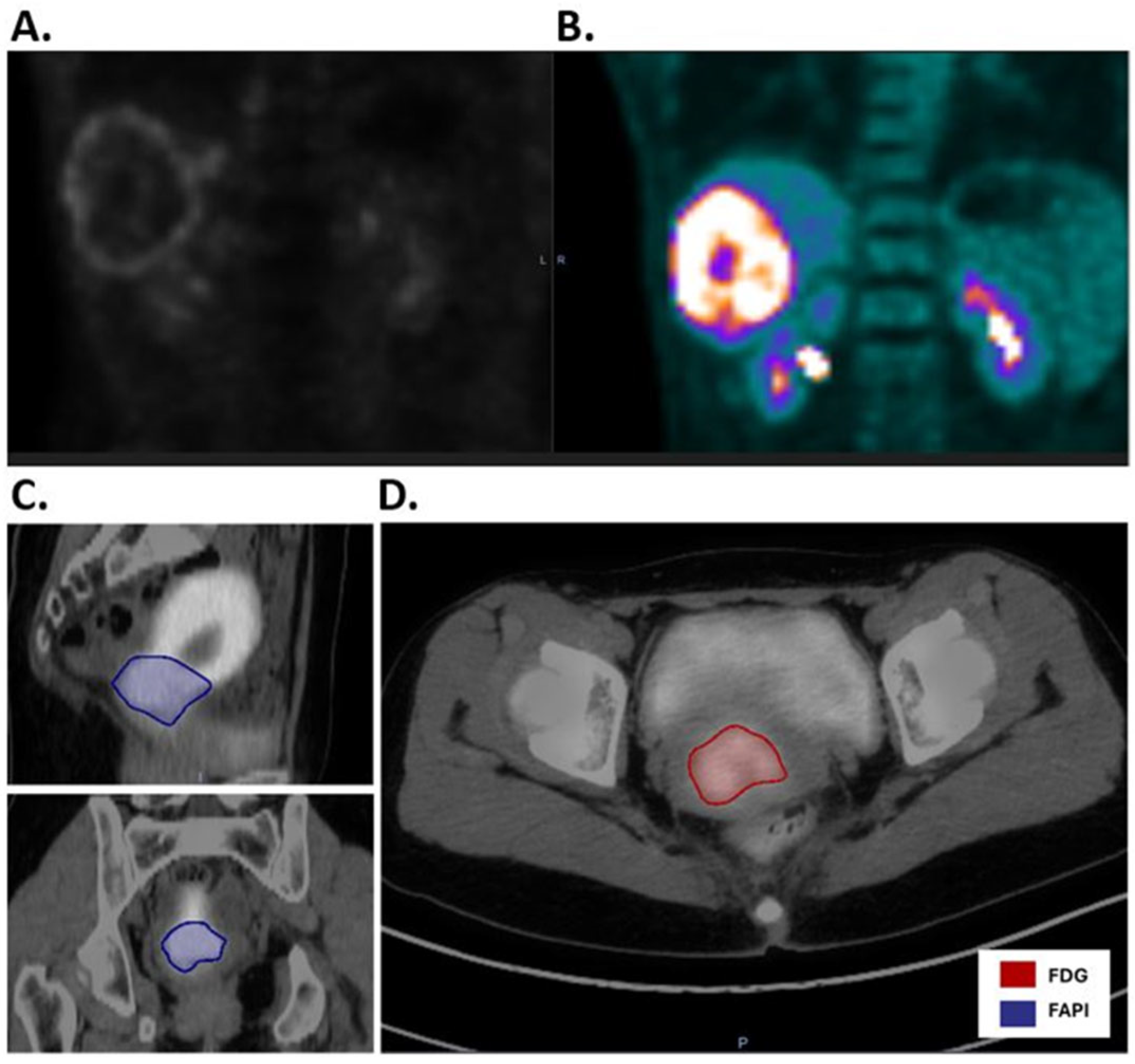Comparative Evaluation of [68Ga]Ga-Fibroblast Activation Protein Inhibitor vs. [18F]FDG as a Novel Radiotracer for Biology-Guided Image Radiotherapy
Simple Summary
Abstract
1. Introduction
2. Materials and Methods
3. Results
3.1. Normalized Net Activity Concentration (NNA) and Normalized Target Signal (NTS)
3.2. Gross Tumor Volume (GTV) Analysis
3.2.1. Pancreatic Cancer
3.2.2. Lung Cancer
3.2.3. Liver Cancer
3.2.4. Cervical Cancer
4. Discussion
5. Conclusions
Supplementary Materials
Author Contributions
Funding
Institutional Review Board Statement
Informed Consent Statement
Data Availability Statement
Acknowledgments
Conflicts of Interest
References
- Oderinde, O.M.; Shirvani, S.M.; Olcott, P.D.; Kuduvalli, G.; Mazin, S.; Larkin, D. The technical design and concept of a PET/CT linac for biology-guided radiotherapy. Clin. Transl. Radiat. Oncol. 2021, 29, 106–112. [Google Scholar] [CrossRef] [PubMed]
- Shirvani, S.M.; Huntzinger, C.J.; Melcher, T.; Olcott, P.D.; Voronenko, Y.; Bartlett-Roberto, J.; Mazin, S. Biology-guided radiotherapy: Redefining the role of radiotherapy in metastatic cancer. Br. J. Radiol. 2021, 94, 20200873. [Google Scholar] [CrossRef] [PubMed]
- Lancia, A.; Ingrosso, G.; Detti, B.; Festa, E.; Bonzano, E.; Linguanti, F.; Camilli, F.; Bertini, N.; La Mattina, S.; Orsatti, C.; et al. Biology-guided radiotherapy in metastatic prostate cancer: Time to push the envelope? Front. Oncol. 2024, 14, 1455428. [Google Scholar] [CrossRef] [PubMed]
- Ladbury, C.; Eustace, N.; Amini, A.; Dandapani, S.; Williams, T. Biology-Guided Radiation Therapy: An Evolving Treatment Paradigm. Surg. Oncol. Clin. N. Am. 2023, 32, 553–568. [Google Scholar] [CrossRef]
- Cuaron, J.; Dunphy, M.; Rimner, A. Role of FDG-PET scans in staging, response assessment, and follow-up care for non-small cell lung cancer. Front. Oncol. 2012, 2, 208. [Google Scholar] [CrossRef]
- Dendl, K.; Koerber, S.A.; Kratochwil, C.; Cardinale, J.; Finck, R.; Dabir, M.; Novruzov, E.; Watabe, T.; Kramer, V.; Choyke, P.L.; et al. FAP and FAPI-PET/CT in Malignant and Non-Malignant Diseases: A Perfect Symbiosis? Cancers 2021, 13, 4946. [Google Scholar] [CrossRef]
- Qin, C.; Shao, F.; Gai, Y.; Liu, Q.; Ruan, W.; Liu, F.; Hu, F.; Lan, X. 68Ga-DOTA-FAPI-04 PET/MR in the Evaluation of Gastric Carcinomas: Comparison with 18F-FDG PET/CT. J. Nucl. Med. 2022, 63, 81–88. [Google Scholar] [CrossRef]
- Wang, Y.; Luo, W.; Li, Y. [68Ga]Ga-FAPI-04 PET MRI/CT in the evaluation of gastric carcinomas compared with [18F]-FDG PET MRI/CT: A meta-analysis. Eur. J. Med. Res. 2023, 28, 34. [Google Scholar] [CrossRef]
- Huang, X.; Xiao, H.; Shi, Y.; Ben, S. Integrating single-cell and bulk RNA sequencing to develop a cancer-associated fibroblast-related signature for immune infiltration prediction and prognosis in lung adenocarcinoma. J. Thorac. Dis. 2023, 15, 1406–1425. [Google Scholar] [CrossRef]
- Kratochwil, C.; Flechsig, P.; Lindner, T.; Abderrahim, L.; Altmann, A.; Mier, W.; Adeberg, S.; Rathke, H.; Röhrich, M.; Winter, H.; et al. (68)Ga-FAPI PET/CT: Tracer Uptake in 28 Different Kinds of Cancer. J. Nucl. Med. 2019, 60, 801–805. [Google Scholar] [CrossRef]
- Dendl, K.; Koerber, S.A.; Finck, R.; Mokoala, K.M.G.; Staudinger, F.; Schillings, L.; Heger, U.; Röhrich, M.; Kratochwil, C.; Sathekge, M.; et al. (68)Ga-FAPI-PET/CT in patients with various gynecological malignancies. Eur. J. Nucl. Med. Mol. Imaging 2021, 48, 4089–4100. [Google Scholar] [CrossRef]
- Chang, W.Y.; Tseng, N.C.; Chen, L.Y.; Chang, C.W.; Huang, Y.Y.; Huang, Y.T.; Ou, Y.C.; Peng, N.J. Comparison of the Detection Performance Between FAP and FDG PET/CT in Various Cancers: A Systemic Review and Meta-analysis. Clin. Nucl. Med. 2023, 48, 132–142. [Google Scholar] [CrossRef]
- Giesel, F.L.; Kratochwil, C.; Schlittenhardt, J.; Dendl, K.; Eiber, M.; Staudinger, F.; Kessler, L.; Fendler, W.P.; Lindner, T.; Koerber, S.A.; et al. Head-to-head intra-individual comparison of biodistribution and tumor uptake of (68)Ga-FAPI and (18)F-FDG PET/CT in cancer patients. Eur. J. Nucl. Med. Mol. Imaging 2021, 48, 4377–4385. [Google Scholar] [CrossRef] [PubMed]
- Surucu, M.; Vitzthum, L.; Chang, D.T.; Gensheimer, M.; Kovalchuk, N.; Han, B.; lagaru, A.; Silva, A.J.D.; Narayanan, M.; Aksoy, D.; et al. Evaluation of Measured PET Activity Metrics from the First-in-Human Biology-Guided Radiotherapy Clinical Trial. In Proceedings of the AAPM 65th Annual Meeting & Exhibition: AAPM, Houston, TX, USA, 23–27 July 2023. [Google Scholar]
- Tibdewal, A.; Patil, M.; Misra, S.; Purandare, N.; Rangarajan, V.; Mummudi, N.; Karimundackal, G.; Jiwnani, S.; Agarwal, J. Optimal Standardized Uptake Value Threshold for Auto contouring of Gross Tumor Volume using Positron Emission Tomography/Computed Tomography in Patients with Operable Nonsmall-Cell Lung Cancer: Comparison with Pathological Tumor Size. Indian J. Nucl. Med. 2021, 36, 7–13. [Google Scholar] [CrossRef] [PubMed]
- Biehl, K.J.; Kong, F.-M.; Dehdashti, F.; Jin, J.-Y.; Mutic, S.; El Naqa, I.; A Siegel, B.; Bradley, J.D. 18F-FDG PET definition of gross tumor volume for radiotherapy of non-small cell lung cancer: Is a single standardized uptake value threshold approach appropriate? J. Nucl. Med. 2006, 47, 1808–1812. [Google Scholar] [PubMed]
- Hirmas, N.; Hamacher, R.; Sraieb, M.; Ingenwerth, M.; Kessler, L.; Pabst, K.M.; Barbato, F.; Lueckerath, K.; Kasper, S.; Nader, M.; et al. Fibroblast-Activation Protein PET and Histopathology in a Single-Center Database of 324 Patients and 21 Tumor Entities. J. Nucl. Med. 2023, 64, 711–716. [Google Scholar] [CrossRef]
- Zhang, H.; Gibbard, G.; Shen, C.; Banks, T.I.; Peng, H.; Da Silva, A.; Kuduvalli, G.; Aguilera, T.A.; Dan, T.; Badiyan, S.N.; et al. Expanding SCINTIX Biology-Guided Radiotherapy Beyond Lung and Bone: A Planning Feasibility and Dosimetric Study on the RefleXion X1 System. Technol. Cancer Res. Treat. 2025, 24, 15330338251365334. [Google Scholar] [CrossRef]
- Cai, B.; Banks, T.I.; Shen, C.; Prasad, R.; Bal, G.; Lin, M.H.; Godley, A.; Pompos, A.; Garant, A.; Westover, K.; et al. Strategies for Offline Adaptive Biology-Guided Radiotherapy (BgRT) on a PET-Linac Platform. Cancers 2025, 17, 2470. [Google Scholar] [CrossRef]
- Surucu, M.; Ashraf, M.R.; Romero, I.O.; Zalavari, L.T.; Pham, D.; Vitzthum, L.K.; Gensheimer, M.F.; Yang, Y.; Xing, L.; Kovalchuk, N.; et al. Commissioning of a novel PET-Linac for biology-guided radiotherapy (BgRT). Med. Phys. 2024, 51, 4389–4401. [Google Scholar] [CrossRef]
- Wang, Q.; Zhao, Y.; Wang, F.; Tan, G. Clustering and machine learning-based integration identify cancer associated fibroblasts genes’ signature in head and neck squamous cell carcinoma. Front. Genet. 2023, 14, 1111816. [Google Scholar] [CrossRef]
- Sunami, Y.; Boker, V.; Kleeff, J. Targeting and Reprograming Cancer-Associated Fibroblasts and the Tumor Microenvironment in Pancreatic Cancer. Cancers 2021, 13, 697. [Google Scholar] [CrossRef] [PubMed]
- Song, M.; He, J.; Pan, Q.Z.; Yang, J.; Zhao, J.; Zhang, Y.J.; Huang, Y.; Tang, Y.; Wang, Q.; He, J.; et al. Cancer-Associated Fibroblast-Mediated Cellular Crosstalk Supports Hepatocellular Carcinoma Progression. Hepatology 2021, 73, 1717–1735. [Google Scholar] [CrossRef] [PubMed]
- Wegen, S.; Roth, K.S.; Weindler, J.; Claus, K.; Linde, P.; Trommer, M.; Akuamoa-Boateng, D.; van Heek, L.; Baues, C.; Schömig-Markiefka, B.; et al. First Clinical Experience With [68Ga]Ga-FAPI-46-PET/CT Versus [18F]F-FDG PET/CT for Nodal Staging in Cervical Cancer. Clin. Nucl. Med. 2023, 48, 150–155. [Google Scholar] [CrossRef]
- Hotta, M.; Rieger, A.C.; Jafarvand, M.G.; Menon, N.; Farolfi, A.; Benz, M.R.; Calais, J. Non-oncologic incidental uptake on FAPI PET/CT imaging. Br. J. Radiol. 2023, 96, 20220463. [Google Scholar] [CrossRef] [PubMed]
- Yuan, Z.; Li, Y.; Zhang, S.; Wang, X.; Dou, H.; Yu, X.; Zhang, Z.; Yang, S.; Xiao, M. Extracellular matrix remodeling in tumor progression and immune escape: From mechanisms to treatments. Mol. Cancer 2023, 22, 48. [Google Scholar] [CrossRef]
- Meyer, C.; Dahlbom, M.; Lindner, T.; Vauclin, S.; Mona, C.; Slavik, R.; Czernin, J.; Haberkorn, U.; Calais, J. Radiation Dosimetry and Biodistribution of (68)Ga-FAPI-46 PET Imaging in Cancer Patients. J. Nucl. Med. 2020, 61, 1171–1177. [Google Scholar] [CrossRef]
- Mona, C.E.; Benz, M.R.; Hikmat, F.; Grogan, T.R.; Lueckerath, K.; Razmaria, A.; Riahi, R.; Slavik, R.; Girgis, M.D.; Carlucci, G.; et al. Correlation of (68)Ga-FAPi-46 PET Biodistribution with FAP Expression by Immunohistochemistry in Patients with Solid Cancers: Interim Analysis of a Prospective Translational Exploratory Study. J. Nucl. Med. 2022, 63, 1021–1026. [Google Scholar] [CrossRef]
- Ruan, D.; Sun, J.; Han, C.; Cai, J.; Yu, L.; Zhao, L.; Pang, Y.; Zuo, C.; Sun, L.; Wang, Z.; et al. (68)Ga-FAPI-46 PET/CT in the evaluation of gliomas: Comparison with (18)F-FDG PET/CT and contrast-enhanced MRI. Theranostics 2024, 14, 6935–6946. [Google Scholar] [CrossRef]
- Giesel, F.L.; Adeberg, S.; Syed, M.; Lindner, T.; Jiménez-Franco, L.D.; Mavriopoulou, E.; Staudinger, F.; Tonndorf-Martini, E.; Regnery, S.; Rieken, S. FAPI-74 PET/CT Using Either (18)F-AlF or Cold-Kit (68)Ga Labeling: Biodistribution, Radiation Dosimetry, and Tumor Delineation in Lung Cancer Patients. J. Nucl. Med. 2021, 62, 201–207. [Google Scholar] [CrossRef]
- Watabe, T.; Naka, S.; Tatsumi, M.; Kamiya, T.; Kimura, T.; Shintani, Y.; Abe, K.; Miyake, T.; Shimazu, K.; Kobayashi, S.; et al. Initial Evaluation of [(18)F]FAPI-74 PET for Various Histopathologically Confirmed Cancers and Benign Lesions. J. Nucl. Med. 2023, 64, 1225–1231. [Google Scholar] [CrossRef]





Disclaimer/Publisher’s Note: The statements, opinions and data contained in all publications are solely those of the individual author(s) and contributor(s) and not of MDPI and/or the editor(s). MDPI and/or the editor(s) disclaim responsibility for any injury to people or property resulting from any ideas, methods, instructions or products referred to in the content. |
© 2025 by the authors. Licensee MDPI, Basel, Switzerland. This article is an open access article distributed under the terms and conditions of the Creative Commons Attribution (CC BY) license (https://creativecommons.org/licenses/by/4.0/).
Share and Cite
Qiu, L.; Chen, Y.; Ketcherside, T.; Wang, Z.; DeWees, T.; Williams, T.M.; Amini, A.; Sampath, S.; Glaser, S.; Chen, Y.-J.; et al. Comparative Evaluation of [68Ga]Ga-Fibroblast Activation Protein Inhibitor vs. [18F]FDG as a Novel Radiotracer for Biology-Guided Image Radiotherapy. Cancers 2025, 17, 3648. https://doi.org/10.3390/cancers17223648
Qiu L, Chen Y, Ketcherside T, Wang Z, DeWees T, Williams TM, Amini A, Sampath S, Glaser S, Chen Y-J, et al. Comparative Evaluation of [68Ga]Ga-Fibroblast Activation Protein Inhibitor vs. [18F]FDG as a Novel Radiotracer for Biology-Guided Image Radiotherapy. Cancers. 2025; 17(22):3648. https://doi.org/10.3390/cancers17223648
Chicago/Turabian StyleQiu, Lin, Yue Chen, Trevor Ketcherside, Zhixing Wang, Todd DeWees, Terence M. Williams, Arya Amini, Sagus Sampath, Scott Glaser, Yi-Jen Chen, and et al. 2025. "Comparative Evaluation of [68Ga]Ga-Fibroblast Activation Protein Inhibitor vs. [18F]FDG as a Novel Radiotracer for Biology-Guided Image Radiotherapy" Cancers 17, no. 22: 3648. https://doi.org/10.3390/cancers17223648
APA StyleQiu, L., Chen, Y., Ketcherside, T., Wang, Z., DeWees, T., Williams, T. M., Amini, A., Sampath, S., Glaser, S., Chen, Y.-J., Lin, L., Leung, D., Liu, A., & McGee, H. M. (2025). Comparative Evaluation of [68Ga]Ga-Fibroblast Activation Protein Inhibitor vs. [18F]FDG as a Novel Radiotracer for Biology-Guided Image Radiotherapy. Cancers, 17(22), 3648. https://doi.org/10.3390/cancers17223648





